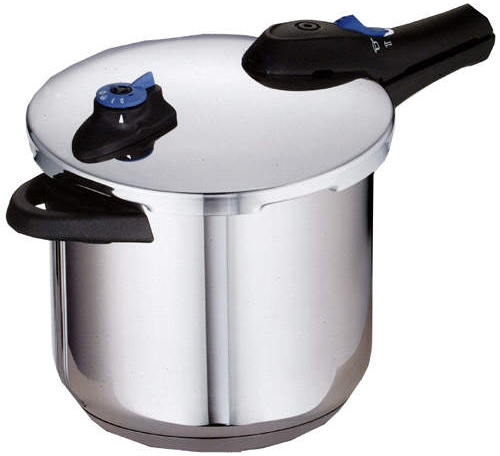"The Single Most Important Piece of Cookware You’ll Ever Own." That's what it says on the cover of the little instruction book that came with my pressure cooker. My purchase was inspired by the amazingly healthy, hearty Italian farming family I lived with in Sicily for three weeks. The family followed a macrobiotic diet, and their pressure cooker was used at least three times a day. I decided that if I couldn’t bring their sunshine, olives, and almonds home with me, I could at least try to re-create their cooking methods.
A few months after returning to snowy Minnesota, my memories of perfectly cooked greens and grains fading quickly, I pulled a shiny but average-looking stainless steel pot out of the box, flipped through the uninspiring recipes included in the booklet, and rolled my eyes at the cookware company’s brash claim. Two years later, however, while I haven’t quite worked up to three times a day, I use my pressure cooker several times a week. I am a total convert.
My love for my pressure cooker is often met with skepticism by those who have yet to experience its wonder firsthand. “Aren’t they dangerous?” is a common concern. Maybe you've been scarred by childhood memories of being told to back away from the pressure cooker, lest it explode and take out an eye (or worse). But if you buy a pressure cooker today, you’ll find it’s gotten a makeover. This isn’t your grandmother’s pressure cooker!
A new pressure cooker comes equipped with all sorts of safety valves, helpful arrows and illustrations, and simple instructions that make it as safe as cooking anything on a stove. Even if you use a hand-me-down, spend a few minutes reading the directions, keep your wits about you in the kitchen (which you hopefully are doing anyway!), and you’ll be fine.
 A more modern version“OK, great," you're thinking, "what do I use it for?” Everything! Anything you would cook in a pot, you can cook in a pressure cooker -- rice and other grains, beans, veggies, soup, meat, fruit, and desserts. It can even be used for canning.
A more modern version“OK, great," you're thinking, "what do I use it for?” Everything! Anything you would cook in a pot, you can cook in a pressure cooker -- rice and other grains, beans, veggies, soup, meat, fruit, and desserts. It can even be used for canning.
Which brings us to the most important question: “why do I love it so much?” It's simple: eating well is important to me, and my time is limited. A pressure cooker is a time saver. Rather than soaking beans overnight and simmering them for hours, I just soak the beans for a few hours, drop them in the pressure cooker, and have them ready in half an hour. (I’ve even lived dangerously and cooked beans without soaking at all, just allowing for a few more minutes of cooking time.) I've cooked brown rice in twenty minutes, and beets in five minutes or less!
Cooking with healthier, whole, non-processed ingredients is something lots of us can do more often, but there’s no way around the fact that cooking a cup of beans is more time-consuming than opening a can. A pressure cooker is made specifically to efficiently cook these ingredients to perfection. Apart from hiring a personal chef, you can’t find a better way to integrate these cooking habits into your already busy life.
But that's not all! My pressure cooker not only makes my life easier, it also saves energy and keeps more flavor, color, and nutritional content in my veggies than cooking them conventionally. And if you act now, we'll even throw in these Ginsu knives! (Just kidding! I couldn't resist.)
There are plenty of pressure cooker-specific recipes and cookbooks out there (you can even get your own book of uninspiring recipes when you purchase your very own cooker). Your instruction book will give you cooking time guidelines for staples like rice and beans, and I’ve found that once you’ve gotten the hang of it, recipe improvisation is pretty easy.
Convinced? To get you started, here’s one of my favorite tried and true pressure cooker recipes, from Deborah Madison’s beautiful cookbook Vegetable Soups.
* * * * * * * * * *
Pinto Bean Soup
Serve over rice with red chile and cheese
(makes 10 cups)
- 2 cups pinto beans
- 2 onions, finally chopped
- 3 garlic cloves, coarsely chopped
- 2 tablespoons sunflower seed or vegetable oil
- 3 epazote sprigs, if available, or 1 teaspoon dried
- 2 teaspoons dried oregano, preferably Mexican
- 2 teaspoons ground cumin
- ½ teaspoon ground coriander
- 3 New Mexican dried red chile pods, stems, seeds, and veins removed
- Sea salt
- 3 tablespoons masa harina
To finish:
- 2 cups cooked white or brown rice
- 1 cup grated Cheddar or Monterey Jack cheese
- 2 tablespoons slivered scallion
- 3 tablespoons chopped cilantro
- Sour cream
- Sort through the beans, give them a rinse, and set aside while you chop the onions and garlic.
- Heat the oil in a pressure cooker and add the onions, garlic, epazote, oregano, cumin, coriander, and dried chiles. Give a stir, then add the beans along with 3 quarts water and 1 ½ teaspoons salt. Fasten the lid, bring the pressure to high, then cook, maintain gthe pressure for 30 minutes. Release the pressure quickly.
- Puree 2 cups of the beans and any large pieces of chile until smooth and return them to the pot. Whisk in the masa harina and simmer for another 10 minutes. Taste for salt and heat, adding more salt or ground child as needed. The texture should be soupy yet punctuated with beans.
- Ladle the beans and their liquid over a mound of rice, then sprinkle on the cheese, scallion, and cilantro, ending with a dollop of sour cream.
 Georgia Rubenstein works at an environmental non-profit in Minneapolis, and loves food in all of its forms -- growing it, cooking it, eating it, feeding it to her worms, and then starting the cycle all over. She can be found philosophizing about food, considering food policy issues, and working to harness the incredible power of food to save the world. She does all sorts of great things with SGT.
Georgia Rubenstein works at an environmental non-profit in Minneapolis, and loves food in all of its forms -- growing it, cooking it, eating it, feeding it to her worms, and then starting the cycle all over. She can be found philosophizing about food, considering food policy issues, and working to harness the incredible power of food to save the world. She does all sorts of great things with SGT.




